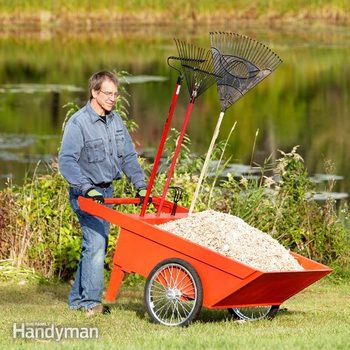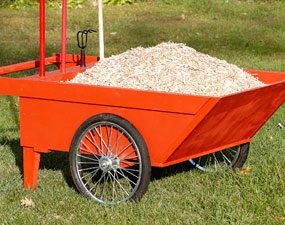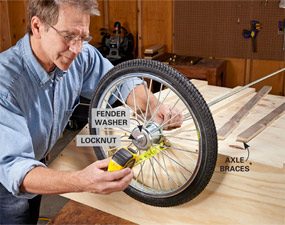How To Add A Handle Stand To Wooden Garden Cart
DIY Garden Cart

This DIY garden cart carries more than a wheelbarrow, easier to load and carries larger loads. We'll show you how to build it in just a handful of steps.
You might also like: TBD
- Time
- Complexity
- Cost
- Multiple Days
- Intermediate
- $51–100
The trouble with wheelbarrows

Meet the builder
A former editor at Family Handyman, Spike Carlsen now spends his days dreaming up ingenious DIY projects. Find 75 more of his clever creations in The Backyard Homestead Guide to Building Projects (Storey Publishers).
Wheelbarrows are great for hauling stuff around the yard—unless you're working on a hill … or trying to negotiate steps and rough terrain … or moving a lot of bulky material like leaves and branch trimmings … or trying to load something big into them.
Spike's wonder cart

Easy to load
Just tilt the cart forward until the angled front rests on the ground.

Onboard tool storage
Built-in holder keeps all kinds of garden tools handy, from trowels to rakes.

Huge load? No problem
With a capacity of about half a yard, you'll move more in less trips with this cart than you could with a wheelbarrow.
Since I added this garden cart to my arsenal of outdoor tools, life has gotten way easier. Two wheels means it doesn't tip; large pneumatic tires means it's easy to push; a big box lets me haul 10 bags of mulch in one load; and because the front tilts down for loading, my aching back doesn't ache as much. I'll still use my trusty wheelbarrow for mixing concrete and hauling the super-heavy stuff, but these days I "cart" nearly everything else.
I designed this cart to be as rugged and durable as any cart you can buy at any price, yet the materials cost about a hundred bucks. It's one of the wisest landscaping investments you can make.
Round up the materials
You'll need a straight-cutting jig to cut the plywood. To learn how to make one, watch the video How to Cut Straight with a Circular Saw. I used exterior plywood and standard pine boards for the structure. You can use treated plywood and lumber, but it may be hard to find treated material that's dry and flat.
I bought wheels at Northern Tool (item No. 145120). The threaded rod, washers and nuts are available at home centers and hardware stores.
Figure A: Garden Cart
Use this exploded view of the garden cart as a construction diagram. The materials list shows what you'll need to get in order to build the cart. The cutting list shows you how many of each part you'll need. Most of the components are cut from a single sheet of plywood (see the plywood diagram).
Video: How to Cut Straight With a Circular Saw
Family Handyman editor, Jeff Gorton, will show you how to make perfectly straight cuts with a circular saw. You will use this circular saw jig over and over again.
ⓘ
Assemble the box

Photo 1: Cut the parts
A homemade straight-cutting jig turns your circular saw into a precision plywood slicer.

Photo 2: Cut the beveled edges
Screw a spacer to the fence of your jig and line up the edge with your cutting line just like you would for a standard cut. Then make the long 45-degree cuts.

Photo 3: Build the box
Secure the panels to one another using construction adhesive and 2-in. screws. Drill pilot holes to avoid splintering the edges of the plywood. Flip the cart upside down and install the three bottom braces (E).
Lay out the plywood as shown in Figure B. Start by cutting the sheet lengthwise into 14-in., 30-in. and 3-1/2-in. strips (Photo 1). After positioning the jig for each cut, clamp or screw it into place. Cut the angled sides (A) from the 14-in. strip and the bottom braces (E) from the 3-1/2-in. strip. Cut the front (C), bottom (D) and back (B) from the 30-in. strip.
If you use your straight-cutting jig, as is, for cutting the 45-degree bevels, you'll cut a bevel on the jig itself, making it unusable for future square cuts. Temporarily modify your jig by screwing a 3/4-in. strip of wood to the jig's fence (Photo 2), positioning the edge of the guide on the cutting line (like you would for a square cut), then make your 45-degree cut.
Drill 1/8-in. holes about 3/8 in. away from the edges of the sides (A), spaced about 4 in. apart. Then secure the front with 2-in. exterior screws through the pre-drilled holes in the sides. Note: To ensure maximum sturdiness, use construction adhesive for all the connections—even for the metal corners.
Install the bottom (Photo 3) flush with the edges of the sides (A). Make sure the front beveled edge of the bottom makes solid contact with the bottom edge of the front (C). To complete the box, add the back (B). If you've cut and assembled everything correctly, there will be a 3-1/2-in. cavity at the back of the box to accommodate the tool rack. If it's a little larger or smaller, no big deal.
Install the wheels

Photo 4: Install the wheel assembly
Install a washer, a wheel, another washer and a locknut on one end of the threaded rod. Measure the overhang required by the wheel assembly, add that length to the other end, then cut the rod to length. Install the cart axle braces and cover.
Turn the cart box upside down. Secure the bottom braces (E). Secure the middle bottom brace so the center of it is exactly 20-3/4 in. away from the back of the back bottom brace (E). If you don't get this positioned right, it will affect the balance of the cart.
Position this assembly (Photo 4) snugly against one side of the cart and measure the amount of space it takes up. Transfer that measurement to the other end of the rod and mark the rod. Cut the rod and install the other wheel assembly. Tip: Before cutting the rod to length, twist a regular nut onto it beyond the cut mark. After making the cut, twist the nut off; it will "recut" any damaged threads so the locknut will go on easier.
Apply glue to the cart axle braces (F), snug them tightly against the axle, then secure them to the middle bottom brace (E) with 2-in. screws. Finally, install the axle cover (G). Note: If you want to strengthen the wheel assembly for hauling heavier loads, use oak for the middle bottom brace, two cart axle braces and cover.
Install the legs, handles and tool rack

Photo 5: Install the legs
Apply two beads of construction adhesive, clamp the legs into place and secure them with screws. The spacer block positions the leg, leaving room for the tool rack.

Photo 6: Strengthen the corners
Cut aluminum angle stock to length, then drill holes and countersink "dimples" for the screw heads. Install the corner braces using construction adhesive and screws.

Photo 7: Install the handle bar
Secure the handle bar by driving screws through each handle into the end of the rail. Add the L-brackets to beef up the connection.

Photo 8: Add a tool rack
Cut three tool rack slats and drill holes for tool handles. Adjust the size and spacing of the holes to suit your tools. Use adhesive and screws to install the slats.
Cut the legs and screw them to the protruding sides (Photo 5). Use the spacer block as shown so the legs can accommodate the upper tool rack slat. Cut and install the handles (J), leaving space at the front for the aluminum angle.
Cut two lengths of aluminum angle. Don't try to measure them; just hold them in place and mark them for cutting. Drill holes and drill countersink "dimples" for the heads of the screws to nest into. Install the aluminum using adhesive and 3/4-in. screws (Photo 6).
Position the handle bar (P) and add the L-brackets (Photo 7) to reinforce the handle. Finally, install the three tool rack slats (Photo 8).
Remove the wheels and apply a coat of high-quality exterior primer, followed by two coats of exterior paint. To keep your cart in good condition, store it inside; if it will be outside, flip it upside down on a couple of scrap 4x4s.
Additional Information
- Construction diagram
- Plywood diagram
- Cutting list
- Materials list
Required Tools for this Project
Have the necessary tools for this DIY project lined up before you start—you'll save time and frustration.
You will also need a Screw gun, Socket/ratchet set, Square &
Tape measure
Similar Projects
How To Add A Handle Stand To Wooden Garden Cart
Source: https://www.familyhandyman.com/project/diy-garden-cart/
Posted by: labordebuirl1989.blogspot.com

0 Response to "How To Add A Handle Stand To Wooden Garden Cart"
Post a Comment